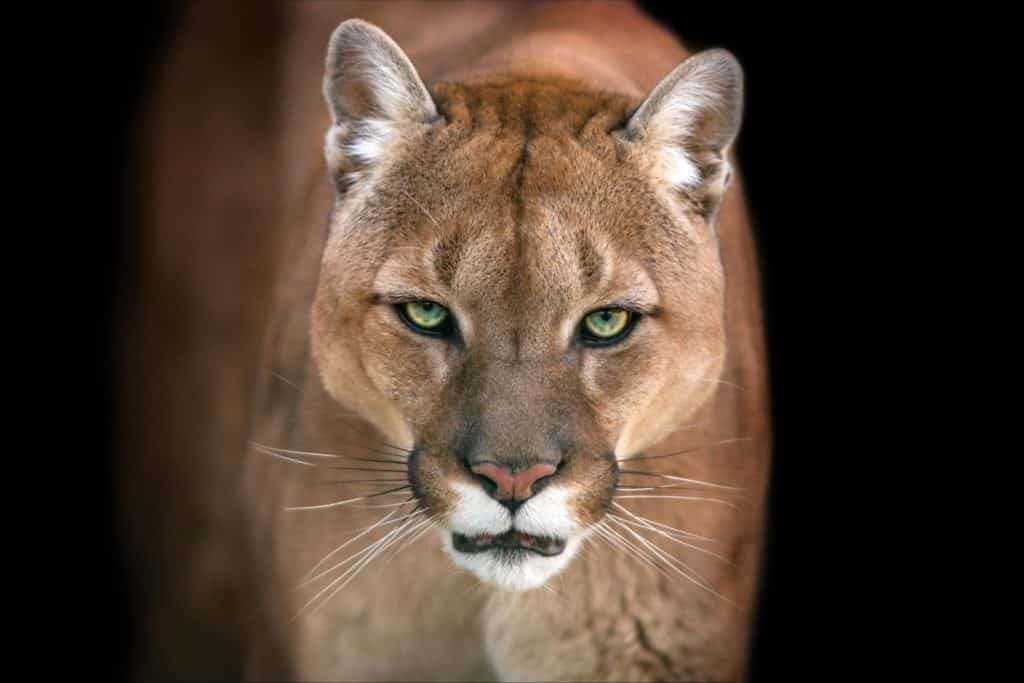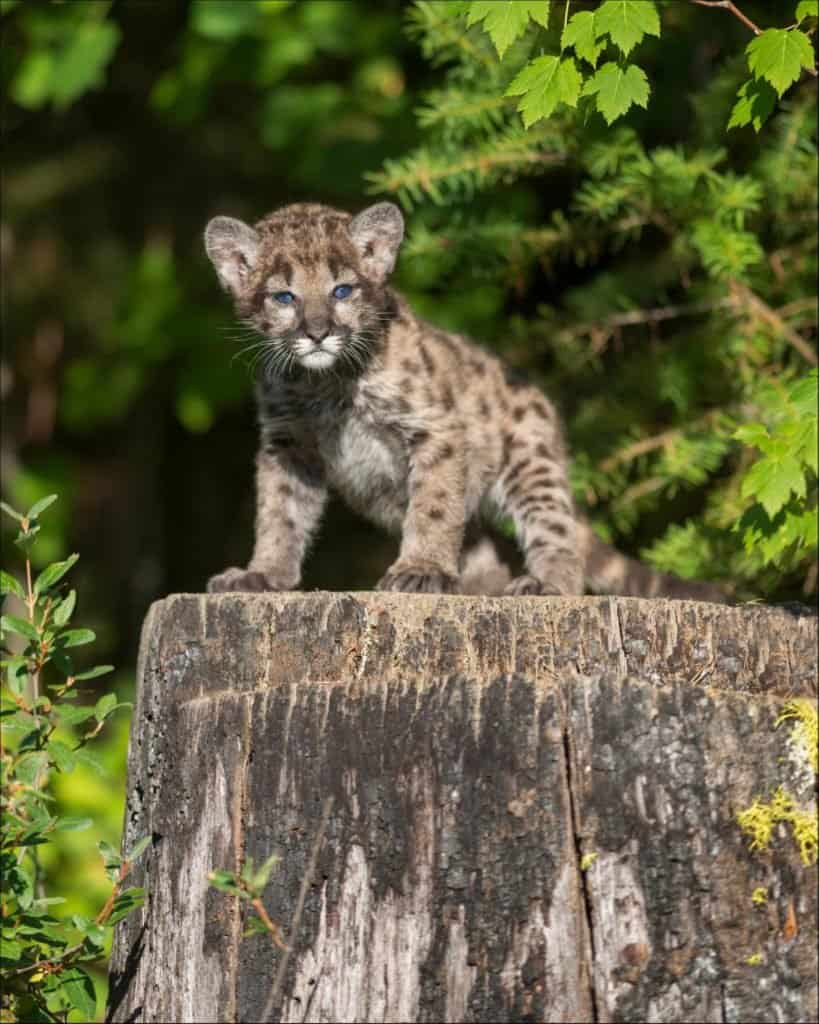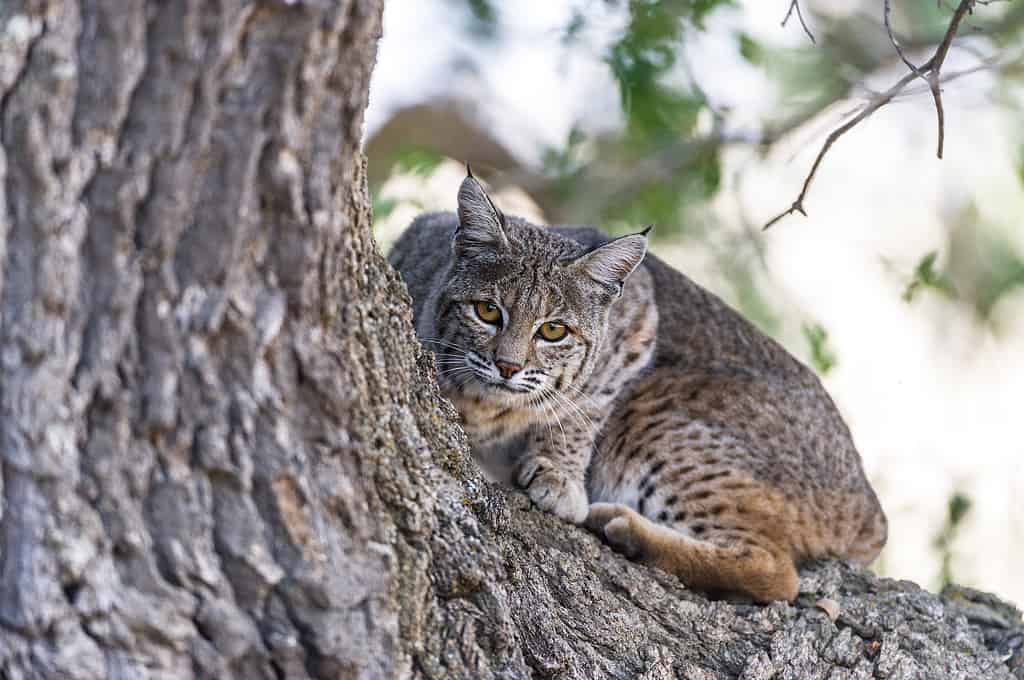Mountain lions are the biggest felines in North America, but they can be found in many other places, too. These animals have deadly abilities that help them hunt their prey. Whether you call them a mountain lion, puma, cougar, panther, or any other name, these cats are not to be trifled with. So, just how dangerous are mountain lions? We will take a closer look at these animals, show you what makes them so deadly, and tell you what to do if you happen to meet one.
How Dangerous Are Mountain Lions?

Mountain lions can kill adult humans along with large mammals.
©Chris Desborough/Shutterstock.com
| Mountain Lion | |
|---|---|
| Size | Weight: 60lbs-190lbs on average, up to 220lbs Length: 5ft-8ft Height: 2ft-3ft at the shoulder |
| Speed | – 30-40 mph |
| Defenses | – High speed – Large size – Good senses – Ability to hide and use fur as camouflage |
| Offensive Capabilities | – Powerful biting force of 1311N, over 400 PSI – Moderately powerful jaws – 2-inch-long canines – 2.5-inch claws |
| Predatory Behavior | – Ambush predator that wraps its forelegs around prey and takes them to the ground – Very quiet hunters that stalk potential prey before attacking |
Mountain lions are very dangerous animals that are capable of killing creatures larger than themselves. They have great hunting senses that help them spot prey along with sharp claws and powerful bites. A single bite around the throat from a mountain lion can be fatal to prey animals and humans alike.
Recently, new stories have emerged about humans fighting off mountain lions. Most of the time, humans survive these attacks by killing the mountain lion or scaring it off. Rarely, humans can even kill mountain lions with their bare hands. Yet, that is difficult unless it’s a juvenile. Fully grown mountain lions can easily weigh as much as an adult, but they have far more power.
The real threat from a mountain lion stems from its ability to sneak up on foes. A human may not notice a mountain lion coming up behind them until it is just a few feet away. By then, they’re already in danger.
How Many Mountain Lion Attacks Happen Each Year?

Mountain lions kill relatively few humans every year.
©Christina Moraes/Shutterstock.com
We must temper our understanding of a mountain lion’s potential danger by realizing that attacks on humans are somewhat rare. Although Washington State has a population of mountain lions that exceeds 1,500, only 20 attacks have been recorded in the last 100 years. Only two of those attacks were fatal. The animals try to bite the head and neck area while using their claws to increase damage.
In North America as a whole, only about 120 attacks have happened, and 27 of them have been fatal in the last 100 years. Attacks are also rare on human beings in Central and South America, but they happen.
Interestingly, some scientists believe that attacks are trending upward and becoming more common. Humans are moving into areas that were once remote. Whether that is the American Southwest or new places in the mountains of South America, humans are encroaching on mountain lions’ territory.
With the potential for human interactions with mountain lions to increase, it’s important to know where they live and how to avoid them.
Where Do Mountain Lions Live?

Mountain lions live throughout the Americas.
©Kwadrat/Shutterstock.com
Mountain lions can be found in North America, Central America, and South America. They can be found mostly on the west coast of Canada and the United States of America.
Here is a list of states in which you can find mountain lions in the United States:
- Arizona
- Arkansas
- California
- Colorado
- Florida
- Idaho
- Illinois (sightings)
- Iowa (sightings)
- Kansas (sightings)
- Michigan (sightings)
- Missouri (sightings)
- Montana
- Nebraska (sightings)
- Nevada
- New Mexico
- New York (sightings)
- North Dakota (sightings)
- Oklahoma (sightings)
- Oregon
- South Dakota
- Tennessee
- Texas
- Utah
- Washington
- Wisconsin (sightings)
- Wyoming
Aside from the states marked “sightings,” the states on this list have stable populations of these apex predators.
Mountain lions can be found in almost all areas of Central America, and across large swaths of South America except for the southernmost tip. Some sightings have renewed beliefs that these massive mammals live on the western coast of South America too.
How to Avoid Mountain Lions

It is not advised to approach a baby mountain lion.
©Nagel Photography/Shutterstock.com
Mountain lions don’t attack humans often. When they do, it’s a cause for concern because they have identified the human as prey. Avoiding these lions isn’t always possible if you go into their territory. That’s why we will identify some measures to avoid mountain lions. Take a look at ways to ward off these creatures:
- If you see a mountain lion and it doesn’t see you, retreat. Leave the area.
- Announce your presence by being loud, wearing bells, or talking.
- Look and listen for signs of a mountain lion. They don’t roar, but they screech. Also, look for claw patterns on trees or animal carcasses.
- Do not hike alone. A lone person is a potential prey, but a group of humans is not worth the risk to the mountain lion.
- Stay close together with your group on a trail.
- Do not approach baby mountain lions.
- Ask about sightings in the area before hiking.
- Only walk on trails during the daytime.
- If you see a mountain lion multiple times, you may be facing an ambush in the future.
What To Do If You Encounter a Mountain Lion

Mountain lions want an easy meal, and they will attack humans for food if possible.
©Ipatov/Shutterstock.com
Mountain lions are ambush predators that attack humans when they appear to be an easy meal. You’ll rarely take them by surprise owing to their amazing senses, but anything is possible. If you find yourself close to a mountain lion, here’s what you need to do:
- Stay calm.
- Move away from the mountain lion if it has not spotted you. Do not attempt to interact with the animal.
- If a mountain lion has spotted you, give it room to escape.
- Do not lose sight of the animal.
- Make yourself look bigger by waving your arms or using your clothes to increase your profile size.
- Do not turn away or bend over to pick up anything. The animal will attack.
If the animal starts behaving aggressively, then:
- Yell at the animal in a loud voice.
- Start throwing whatever you have at the animal to make it turn away.
- Get ready to fight if it comes close, protecting your head and neck from the initial onslaught.
- Fight back with everything you have if attacked. Use sticks, rocks, pocketknives, or try to choke the animal to death.
- Report attacks to local authorities.
Oftentimes, the animal just wants you to leave its territory, but other times it will be hunting humans for food. Even then, it may determine that you’re not worth the trouble and move on if you appear too dangerous for it or fight back.
How dangerous are mountain lions? They’re very dangerous, but they’re also not numerous or common in areas with people. As long as you know how to recognize a mountain lion and how to stay safe in the wilderness, these animals don’t have to dominate your thoughts.
Bonus: Do Bobcats Attack Humans?

It’s very rare for a
bobcat
to attack a human, but they will prey on small, unattended pets if given the chance.
©iStock.com/brentawp
We’ve investigated facts surrounding mountain lions and the threats they pose to humans. Another large cat that lives in the wild in parts of North America is the bobcat. Do bobcats pose a similar threat to humans? How often do they attack, and are they as dangerous as mountain lions?
Bobcats (also called lynxes) are smaller than mountain lions, typically weighing between 15 to 40 lbs. Sometimes bobcats are comparable in size to larger domestic cats, weighing up to 20 lbs. Due to their size, they feed on smaller prey like rabbits, birds, squirrels, rats, and chickens. They would not likely view a large human in terms of a potential meal. However, they can be drawn to yards by unattended small pets, which are attractive prey to bobcats.
Other things that can attract bobcats to your property include:
- Bird baths
- Pools
- Fountains
- Water for livestock
- Food for livestock
- Space underneath decks
- Thick brush and shade
- Unoccupied yards to sunbathe in
Bobcats usually run away from a human. If you encounter one, the best thing to do is face the bobcat, stand your ground (don’t flee), and make noise. Do not, however, purposefully approach a bobcat. If a bobcat boldly approaches you, it may have rabies. While reports of bobcat attacks on humans hardly exist, there was a resident of Saddlebrooke, Arizona, who suffered a bobcat attack. Authorities believed it to be rabid, but it was not successfully captured to prove as much. The man bitten was forced to undergo a full round of rabies treatments to protect him from potential infection.
In summation, bobcats do not pose the same threat to humans that mountain lions do. As long as you react appropriately if an encounter with a bobcat occurs, you’ll likely walk away unscathed. The chances of being attacked by a mountain lion are greater.
Thank you for reading! Have some feedback for us? Contact the AZ Animals editorial team.








